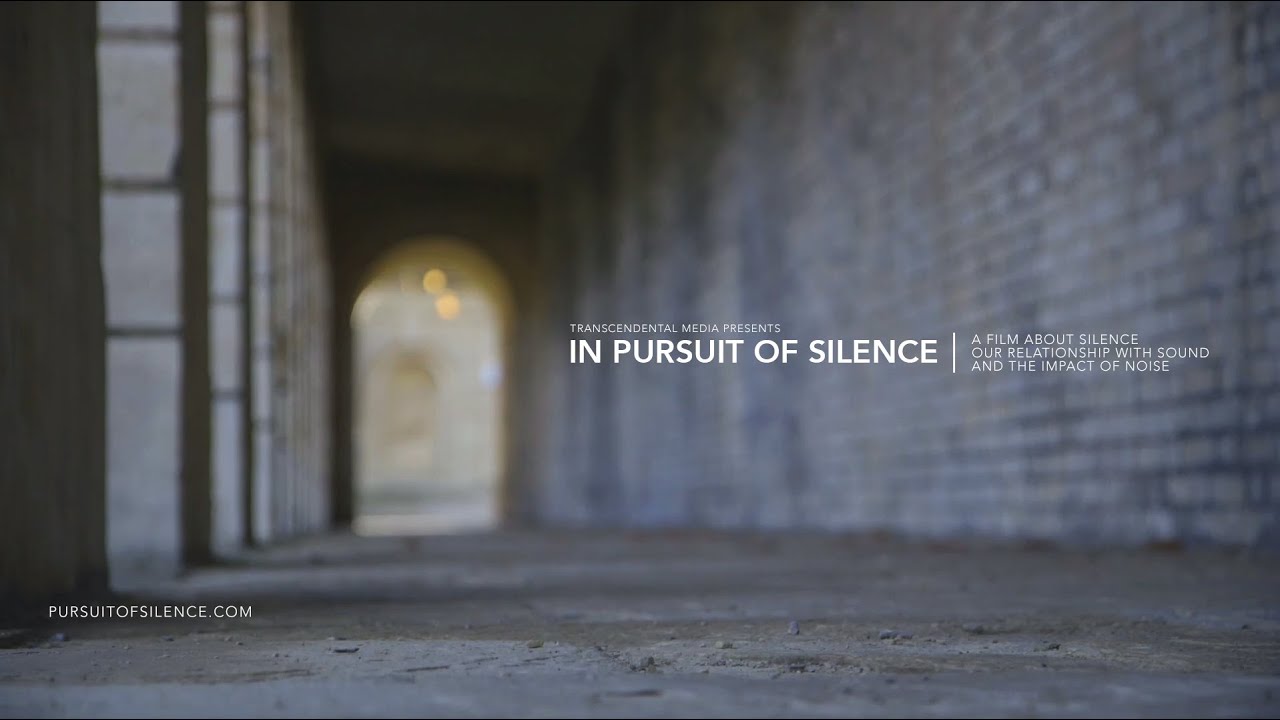In Jean-Luc Godard’s 1964 film Bande A Parte, there’s a famous scene in which the film’s three misfits decide to conduct a ‘minute silence’ in a busy café purely because they don’t have anything else to do. Godard’s playful observance of cinema’s often meaningless pursuit of noise, is becoming more prevalent in today’s multiplex Marvelverse. A recent study carried out by the Audio Engineer Society revealed cinemas regularly exceed the safe maximum volume of 85 decibels by almost 50%. Combined with the average shot length of a studio movie falling well below the 5-second mark, audiences routinely have less time for reflective, introspective thought. The silence in Godard’s film ends after only 36 seconds when one of the characters resigns, “that’s enough for me. I’m going to put on a record”. So what are the implications of exposure to excessive noise levels and how does this alter the way we watch films?
The answer might just be found in Patrick Shen’s In Pursuit Of SIlence a meditative documentary that explores the physical and psychological implications of noise pollution and the importance of silence in a noisy world. The increasing popularity of 3D and IMAX experiences in film-going is indicative of this, with audiences becoming more immersed in cinema as mere stimulus. However, for many filmmakers, silence can be one of the most effective tools in their arsenal. It can relay boredom, the sensation of falling in love, or the fear of death. It also allows audiences the opportunity to think about what they’re viewing and imprint their own interpretation onto the image. Austrian director Michael Haneke is perhaps the master of silence. His work is often criticized for being too violent, yet actual instances of violence in his films are rare. It’s actually his use of sound, or rather the lack of it, that gives shape and context to the violence and makes his films often so distressing. Acts of violence are followed by a moment of silence, like the disturbing suicide in his 2005 film Cache, or the deafening quiet that follows the massacre in 1997’s Funny Games when the mother switches off the television and is given a moment to grieve the death of her son. These instances of silence can, at first, feel like a salvation, but in reality merely act to underline the cruelty Haneke sees in the world.
Shen’s documentary employs similar instances of jarring soundlessness. The film opens with silence, almost 5 minutes of it, an alienating experience for audiences accustomed to the excessive rumble of the multiplex. This silence is actually a homage to composer John Cage and his ground-breaking composition 4’33 that consists of 4 minutes and 33 seconds of total silence. When Cage first premiered the piece in 1952 in the bustling metropolis of New York, audiences were perplexed, unsure of what to make of the quiet. Silence has been instrumental in creating some of cinema’s most profound moments. In his video essay, <a href=https://vimeo.com/98240271" target="out">The Art of Silence, Tony Zhou discusses the sound design in Martin Scorsese’s films, such as 1980’s Raging Bull, 1990’s Goodfellas and 2010’s Shutter Island, to demonstrate how silence can elevate the impact of a scene. Zhou pays special attention to how Scorsese uses silence to amplify the tension of key narrative moments where characters are forced into making difficult decisions. Zhou’s essay also highlights how the deployment of silence has evolved over time, juxtaposing similar scenes from Richard Donner’s 1978 Superman and Zach Snyder’s 2013 reboot, Man of Steel. Both scenes employ silence to emphasise Superman’s anguish at losing a loved one. But while Donner’s film lingers on the silence, allowing the audience time to imprint their own experiences onto Superman’s grief, Snyder cuts, on more than one occasion, to Superman receiving a hug – just in case it wasn’t clear he was feeling sad.
But why exactly do we need more silence in our lives, after all loudness can be thrilling. If used correctly it can give a scene impact and immerse the viewer into the film’s world. The shower scene in Alfred Hitchcock’s Psycho, wouldn’t be as traumatising if it wasn’t for the accompanying sound of shrieking strings. The discovery of the monolith in Stanley Kubrick’s 2001: A Space Odyssey wouldn’t have provoked as much awe and wonder if it wasn’t for the ominous hum and subsequent high-pitched squeal that accompany its discovery. Loud sounds excite us because our bodies are preprogramed to react to them by raising our adrenaline levels. Sadly, this hunger to thrill, to keep energy levels constantly high has resulted in an onslaught of loud, yet largely superficial films.
In a report for the Ear, Nose and Throat Journal, Dr. Bedolla explains that “certain types of high-spectacle movies, such as Transformers, have decibel levels of 120 for significant periods and at some points get to 130 decibels. 130 decibels is a jet engine at about 10 meters”. Stress, sleep deprivation, hypertension and hearing loss have all been linked to noise pollution, and the strength of Shen’s documentary is how eloquently it articulates the potential health risks associated with this kind of exposure. “All of our physical rhythms are being affected by sound outside us all the time,” says Julian Treasure, chairman of The Sound Agency. He explains to Shen how noise affects our bodies in four different ways: physiologically, psychological, behaviourally and, perhaps most importantly when discussing sound in cinema, cognitively. The brain’s input channel is relatively limited, and the human mind can only focus on roughly 1.6 human conversations at a time. Therefore, an excessively noisy film may leave audiences unable to think about what they’re viewing, suggesting often only a surface reading of the text is being consumed.
One of the first people we meet during In Pursuit of Silence’s is Greg Hindy, a Yale graduate walking from New Hampshire to Los Angeles under a self-imposed vow of silence. He claims silence “should be explored… not explained,” Perhaps one of cinema’s greatest explorers of silence was Russian director Andrei Tarkovsky, who used silence to define place, both literal and psychological. Creating a dimensional space around the film, Tarkovsky’s films allow the audience to inhabit two worlds at once: one of action and incident, and another that transcends narrative to engage with the film’s loftier themes.
Perhaps the best example of this can be found in his 1979 film Stalker which presents a disorientating disconnect between what is heard and what is seen, with the absence of sound creating an otherworldly sensation as the three protagonists enter the film’s fabled ‘Zone’. Tarkovsky creates a haunting atmosphere, not through the absence of sound, but rather by amplifying, and thus focusing attention on natural sounds such as rain, wind and the cry of a cuckoo (a recurring motif in many of his films). This stripped back soundscape creates a greater identification with the surroundings whilst challenging the viewer’s notion of reality, freeing the mind to explore the external forces exerting their will on the characters.
In his book Sculpting in Time, Tarkovsky stated that his use of sound was hugely influenced by both Robert Bresson and Ingmar Bergman. Both of these directors used sound to create a heightened experience of listening that focuses the viewer on the characters’ internal processes. Bresson, for example, is quoted as saying “What is for the eye must not duplicate what is for the ear”, and often used silence to draw attention to the world outside the frame. Sound is of key importance when decoding Bresson’s work, no more so than in the quivering quietude of 1956’s A Man Escaped. In this tale of a French POW’s attempts to escape his captors, Bresson builds tension with intense moments of silence that allude to threat of the encroaching Nazi guards and the fear of being caught.
It’s difficult to talk about silence without engaging with spirituality. In Shen’s film Theologian Maggie Ross claims “God dwells in the silence of eternity”, but God’s presence can be felt more acutely in the silent corners of Ingmar Bergman’s films. Questions of spirituality, faith and mortality are often answered poignantly by Bergman in lengthened moments of silence. In the opening minutes of 1963’s The Silence the final film in the director’s Trilogy Of Faith, show two women and a young boy travelling together on a train. The credits roll accompanied by the sound of a clock ticking at an unnaturally fast pace. This powerful metaphor for the unstoppable flow of time comes to halt when the scene suddenly cuts to a silent black screen, followed by a close up shot of the boy’s face. Life and death separated by a moment of quiet contemplation.
One of the most transfixing moments in Shen’s documentary comes in the Denali National Park in Alaska, where the park’s “soundscape technician” reflects on the relationship between silence and space. Sadly, even in this remotest of idylls, there’s no avoiding the noise of traffic. Similarly in Akira Kurosawa’s 1952 film Ikiru, street noise removes us from the sanctuary of silence. After Kanji Watanabe (Takashi Shimura) receives the news of his imminent death, he leaves the doctor’s surgery in a daze and begins walking down a busy street absentmindedly. The camera follows him as he walks in absolute silence, the absence of external sound emphasising his obsessed state of mind and proximity to death. Then, without warning Kurosawa thrusts him back into the world with a startling jolt of noise, much to the shock of Kanji and the audience. This technique has been recreated multiple times, but perhaps never quite as unashamedly as Darren Aronofski’s 2006 film The Fountain in which Hugh Jackman’s character mimics Kanji by walking down a busy street in complete silence as he comprehends the news of his wife’s imminent death. In both these scenes silence allows the audience to forge a deeper relationship with the character, which, in turn, results in a far more emotionally authentic response to the film.
Shen’s documentary argues that although we think we’re used to noise, we’re actually just coping with it. Art is a two-way conversation that requires a degree of interrogation to function. Improvements to sound technology mean films can be played without the risk of distortion, however this doesn’t necessary mean they should. In Pursuit of Silence is a silent protest for a quieter world, a message perhaps becoming more relevant in increasingly stimulus-reliant filmmaking culture.
In Pursuit Of Silence is in selected cinemas now



